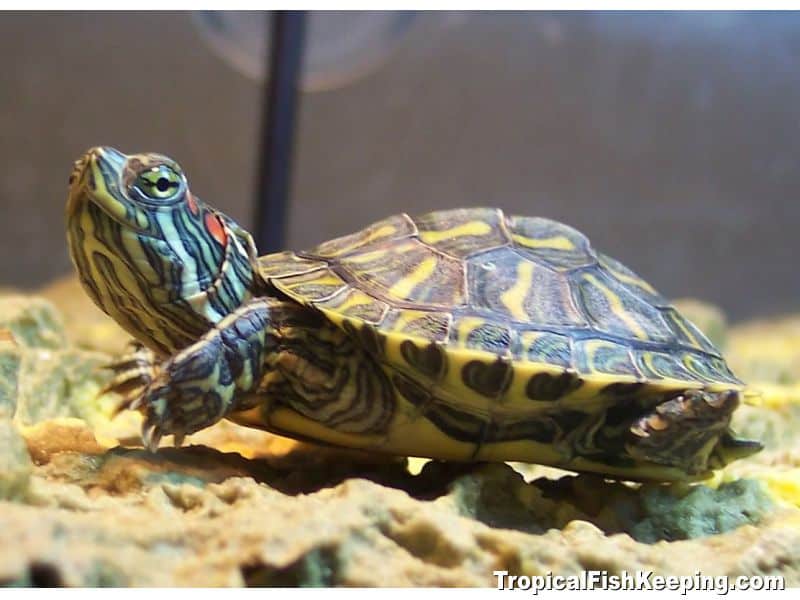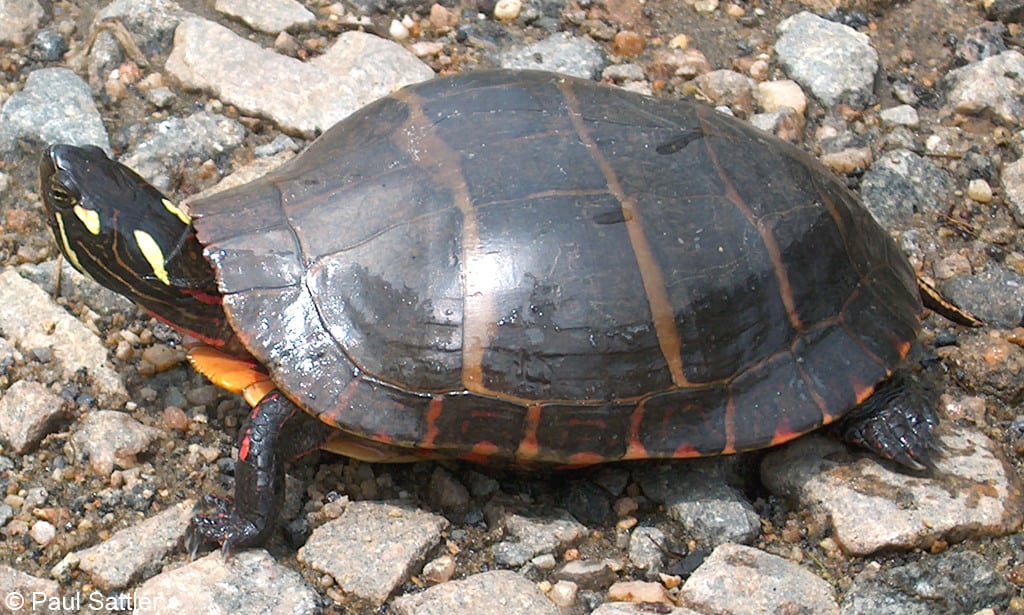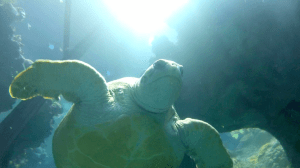This week’s fish of the week is one of the fishes’ aquatic cousins: Aquatic Turtles
Today is my father’s birthday, and he requested that we learn about turtles! This is a short introduction to turtle-keeping and is by no means a comprehensive guide. If you are considering adding a turtle to your family, look into purchasing a book on turtle care and discuss any questions and concerns with an exotic veterinarian (a veterinarian who works with reptiles specifically). Aquatic Veterinary Services of Northern California is happy to answer any questions on turtle keeping you may have.
Aquatic turtles spend most of their time in the water, but like to come out and lie

in the sun on a warm rock, also called basking. There are two main pet species, the Painted Turtle and the Red-Eared Slider. Do NOT take turtles from the wild and turn them into pets. Turtles can carry lots of parasites and are notorious for transmitting salmonella to humans. (Do not lick your turtle!) There are many national and state regulations pertaining to turtles as pets, so please do some research before purchasing a pet turtle. Most of the regulations are based on the size of the turtle you intend to purchase. Please purchase your turtle from a reliable pet store. Do NOT release

your pet turtle into the wild. Red-eared sliders are an invasive species in some parts of the U.S., where they have out-competed native species for resources.
If you want to get a pet turtle, there are several important things you need to consider.
– Aquatic turtles require a clean water tank with a dry space for basking. You will need a proper water filter and regular water changes. It is important to keep your water around a proper temperature, so make sure you have an aquatic water heater to keep to water warm for your turtle. Turtle water gets dirty fast, so try to change out at least 50% of the water while removing any debris at least twice a week. Even though turtles breathe air, it is very important to keep their water clean.
– UVB light bulbs are required for indoor turtles. Natural sunlight is ideal, but UVB rays are essential to turtle health. Keep the bulb changed regularly and make sure there is no glass or plastic between the bulb and the turtle.
– In the wild, turtles hibernate during winter. However, this is not possible with indoor temperature regulation. You will need to keep your turtle’s lights (with UVB bulbs) on for at least 12 hours in winter to keep them from going into inappropriate hibernation.
– Make sure the basking area is large enough for your turtle to get out and

dry completely. If you have a female turtle, she may lay eggs even without a male presence. They will be infertile, but need to be removed. If you see turtle eggs in the tank water, it means that the turtle does not have enough dry space!
– Egg binding can occur in turtles with insufficient dry space, nutritional deficiencies, and/or shell deformities and can be fatal. If your turtle is acting lethargic (not moving much) and not swimming around, it may be time for a trip to the vet. A quick x-ray of your turtle can show eggs that are stuck or substrate in the intestines.
– Turtles are notorious for swallowing substrate! Those small, decorative rocks at the bottom of your turtle tank may look pretty, but if they fit in a turtle’s mouth, they could get stuck in a turtle’s intestines. If you see your turtle eating their substrate, they don’t eat their food, or they’re acting lethargic, take your turtle to a vet. Instead of small gravel, use larger rocks that can’t be swallowed or sand. Larger rocks are easier to clean around and some turtles may even eat the sand!
– You will need a large tank for your turtle! It will need to be a lot larger than you may expect. Don’t forget to plan for a basking area large enough for your turtle. Your turtle will continue to grow, so make sure that you purchase a tank they can grow into. You can add a variety of logs for the turtles to play in and climb on. They like to have some entertainment while they’re swimming around. If you are using real branches, make sure to soak them overnight and treat them with a dilute bleach solution before adding them to the tank. Rinse thoroughly before adding them to the tank. You will need to scrub them regularly to keep stuff from growing on them!
What do turtles eat? Now that you’re all set to make your turtle feel nice at home, what should you serve them for meals? Most aquatic turtles will eat a variety of things, including veggies, prepared gel (found online and at pet stores) and bugs. You will need to supplement your turtle with calcium and multivitamins. This can be purchased in powder form and added to their food. Feed a good variety of foods to keep your turtle eating well and nutritionally balanced. Try to avoid empty foods, such as head lettuce and celery. Avoid veggies from the brassica family, which included broccoli, bok-choy, brussel sprouts, and cabbage, and spinach. Try collards, romaine or dandelion. Sweet potatoes and carrots are good as well. Try not to feed the same foods all the time and watch out for turtle “candy,” such as green beans, bananas, apples, and blueberries. Cantaloupe is good for a fruit. Good bugs include crickets, slugs, mealworms and waxworms. You don’t need to feed too many bugs. You can also feed fish to your turtle, just as long as it has not been processed or frozen. These processes can severely decrease their nutrition for your turtle.
Is my turtle sick? How can you tell if your turtle isn’t feeling quite right?
Most turtles get sick from a poor diet, lack of sunlight (UVB), low temperature and poor husbandry. As mentioned before, it is VERY IMPORTANT to keep your turtle’s water clean. Water changes should be performed MINIMALLY twice a week. If you notice your turtle is lethargic, not moving from one spot or covered in waste and debris, immediately isolate it from other turtles. Take your turtle to an exotic veterinarian ASAP. Aquatic Veterinary Services of Northern California is happy to come and visit your sick turtle at home.
Common veterinary problems include fungal growth (fuzzy white spots), shell rot, swollen soft tissue (especially eyes), and crusty scutes (top layer of shell). Respiratory tract infections are relatively common and manifest as floating (rather than swimming), gasping (you may hear a wheezing sound), a runny/bubbly nose and swollen eyes. Contact your veterinarian and keep your turtle in a slightly warmer environment (85-90o F). Physical trauma from other tank inhabitants and sharp/abrasive objects in the tank should be treated immediately. Antibiotic ointments are available at most pet supply stores that cater to reptiles. It is important to remember to dry the affected area and gently debride or scrub the area with a clean, warm washcloth prior to applying the antibiotic. Keep you turtle out of the water for at 15-20 minutes after applying the antibiotic to make sure some gets into the wound.
In the fall, your turtle may start to slow down and prepare for hibernation. If you would like to avoid this, use appropriate lighting to make the days feel longer.
If you are ever concerned about your turtle’s behavior, call your veterinarian. It is important for turtles to see a veterinarian when they are sick, just like your cat, dog or any other pets. Do not keep fish and turtle in the same enclosure. Fish are the natural prey for turtles, so although it may look like a pretty tank, it is not a good idea.
If you have any additional questions or comments, please e-mail ncfishvet@gmail.com
What about sea turtles?
Sea turtles are NOT kept in aquariums unless they are deemed un-releasable by

law. These animals have permanent disabilities that make them extremely unlikely to survive in the wild. Many aquariums along the Pacific and Atlantic Oceans support sea turtle hospitals, where sea turtles are rehabilitated and treated for disease. These animals wash up along the beach and are brought to the sea turtle rehab center until they are able to return to the wild. If you see a sea turtle on the beach, do NOT approach it. Sometimes, turtles come up on the beach to rest or nest and they will not appreciate being disturbed. If you see a turtle, please call your local sea turtle rescue organization. For a listing of rescue organizations, see the National Marine Fisheries Service Web Database. If you live on the coast, look up the number of the turtle center closest to you and save the number in your phone so you’ll have it when you’re walking along the beach.
